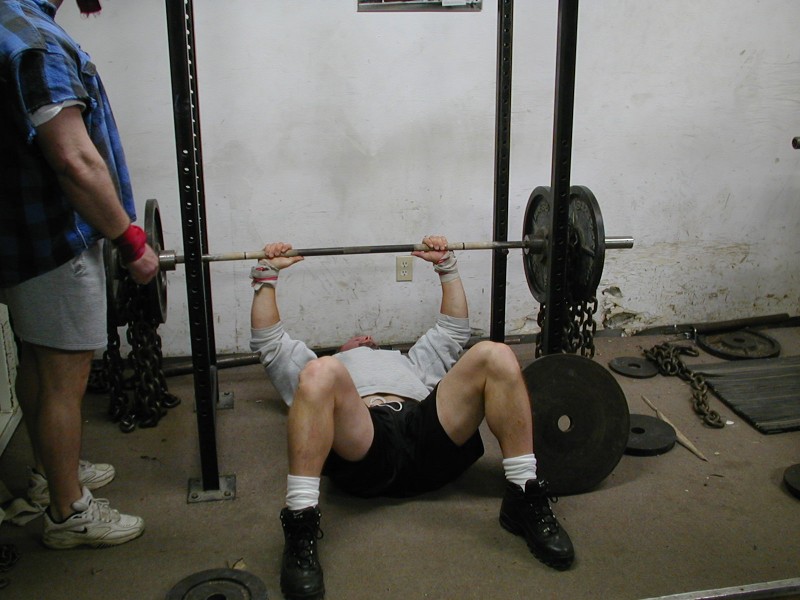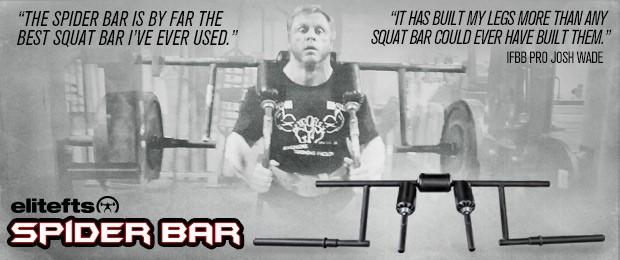
Originally published December 11th, 2011
There are a ton of questions on how to work up to a 1RM on max effort day. While many lifters don’t use percentages, it certainly makes it easier on coaches and novices on how to pick attempts. Since many people are new to doing these movements are not familiar with their maxes, use the following to help guide you.
- 2-Board Press: 105% of 1RM of raw bench press
- 3-Board Press: 110-115% of 1RM of raw bench press
- Floor Press: 90-95% of 1RM of raw bench press
All of these movements are done with a medium grip (pinky on the ring of the Power Bar) and all 1RM on the raw bench press are done with a maximum legal grip. If you use different grips, then I have no idea of the approximate percentages.
I’m going to point out that these numbers are approximate values and should be used accordingly. These are not set numbers. So, if you're reading this article and already have a calculator in hand and find some kind of discrepancy, it is OK, and you will live. Everyone is different.
Also, you will notice that there are no numbers for the incline press or the reverse band press. This is because there are a ton of different angles of incline presses, and there are too many discrepancies on how to set up a reverse band press.
If you are guessing your 1RM, always err on the side of too light. Now that you know an approximate number for your 1RM on each movement, use the following set/rep scheme. Notice that the percentages start at 50 percent. This is NOT your first set. Warm-up to that first set any way that you want.
Many times, it could be two to three sets before you are ready for the 50 percent set. For a stronger, more experienced lifter (“experienced” is the code word for always being beaten up and hurting), it may take five or more sets to be ready for your 50 percent set.
- 1x5 @ 50%
- 1x3 @ 60%
- 1x2 @ 70%
- 1x1 @ 80%
- 1x1 @ 90%
- 1x1 @ 95%
- 1x1 @ 100% or new PR
Here’s how it would work in a real life example. The lifter has a best two-board press of 450 pounds.
- 225 x 5
- 275 x 3
- 315 x 2
- 365 x 1
- 405 x 1
- 425 x 1
- 455 or 460 x 1

Now, let’s say that you don’t know your best performance on a floor press, but you know your 1RM on the bench press. Your best bench press is 315 pounds, and 90 percent of 315 is 285. Your goal is to do perform a floor press with 285, thus 285 equals 100 percent.
- 145 x 5
- 170 x 3
- 200 x 2
- 230 x 1
- 255 x 1
- 270 x 1
- 285 x 1
Because this is your first time performing the floor press, I would advise you to stop here. Don’t worry if this isn’t a true max effort. It’s not going to kill you if you don’t work all the way up. You’ve got another week of the exercise.
The next week, you have a new goal to shoot for because your new goal is probably going to be fairly close to 285 pounds, I'd advise you to use the same weights or fairly close for your warm-up sets as used before. If you feel like you were good for at least 300, then base the percentages on that number (300).
The percents will become a thing of the past the more experienced you get. You will begin to know instinctively how to work up to a 1RM. These percentages are great for the beginner to this program, as well as coaches and trainers that would like a more concrete way (and something they can put on paper) for their athletes.
With the squat and deadlift variations, we found that it is very difficult to find any kind of percent carryover between lifts. For example, if you can parallel squat 500 pounds, that doesn’t mean you're able to squat 475 with a SS Yoke Bar on a parallel box. There are way too many variables with the squat and deadlift.
My advice to you is to simply estimate some very reasonable goals for each movement. In fact, if you are completely new to the SS Yoke Bar or any other movements or bars, simply take a couple of training sessions to familiarize yourself. Don’t try to work up to a 1RM. Learn how to do the exercise correctly and safely.
Let’s say that you squat 500 pounds and are trying the SS Yoke Bar for the first time. Below is how you'd use the bar the first couple of weeks. For all you number freaks and statisticians out there, we always count the bar as being 45 pounds just because it’s easier this way! Plus, it doesn’t matter how much you do on these movements as long as the way that you track it is consistent.
Week 1
- Bar x 10
- 95 x 5
- 135 x 5
- 225 x 5
- 275 x 3
- 275 x 3
Week 2
- Bar x 10
- 95 x 5
- 135 x 5
- 225 x 5
- 275 x 3
- 315 x 3
After the second workout, set a goal (say 365 x 1) and use the set/rep/percentage scheme as outlined above.
Some notes to help you:
Once you establish a record with a certain grip, STAY WITH THAT GRIP! While it’s nice to use different grips and more variations, you won’t ever know how you're progressing if you constantly use different grips.
The box height is the same concept as the grip; use the same box height when using a certain bar. While you can have a low box, parallel, and high box record for each bar, this can get confusing for some. Just stick with a parallel box for now.
When you are beginning, you'll probably break more records than the PMRC (a little Tipper Gore humor…). This is typical and very fun. Run with it but not at the expense of bad form. A bruised ego is better than a bruised sternum.
Use a grease board to chart your progress. If you are in a home gym, proudly display your records in the garage, basement, or family room. If you put it up in your house, make the max effort movements appear to be stock exchange symbols and impress your neighbors.
Don’t use a ton of different movements. Pick about five different max effort movements for the bench press, as shown below:
- 2-board press
- 3-board press
- Close grip bench press
- Incline bench press
- Reverse band press
And the following exercises for the squat and deadlift:
- SS Yoke Bar box squat (parallel box)
- Manta Ray box squat (parallel box)
- Cambered bar box squat (parallel box)
- Deadlift off of 3-inch elevated platform
- Rack pulls from below the knees
- Reverse band deadlift
To sum it up:
- Find your goal weight of the day for the exercise.
- Figure out which weights to use for each percentage.
- Train and establish a 1RM.
- Use new (and correct) 1RM for upcoming workouts.









